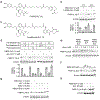Electrophilic PROTACs that degrade nuclear proteins by engaging DCAF16
- PMID: 31209349
- PMCID: PMC6592777
- DOI: 10.1038/s41589-019-0279-5
Electrophilic PROTACs that degrade nuclear proteins by engaging DCAF16
Abstract
Ligand-dependent protein degradation has emerged as a compelling strategy to pharmacologically control the protein content of cells. So far, however, only a limited number of E3 ligases have been found to support this process. Here, we use a chemical proteomic strategy that leverages broadly reactive, cysteine-directed electrophilic fragments coupled to selective ligands for intracellular proteins (for example, SLF for FKBP12, JQ1 for BRD4) to screen for heterobifunctional degrader compounds (or proteolysis targeting chimeras, PROTACs) that operate by covalent adduction of E3 ligases. This approach identified DCAF16-a poorly characterized substrate recognition component of CUL4-DDB1 E3 ubiquitin ligases-as a target of electrophilic PROTACs that promote the nuclear-restricted degradation of proteins. We find that only a modest fraction (~10-40%) of DCAF16 needs to be modified to support protein degradation, pointing to the potential for electrophilic PROTACs to induce neosubstrate degradation without substantially perturbing the function of the participating E3 ligase.
Figures






Comment in
-
Stick it to E3s.Nat Chem Biol. 2019 Jul;15(7):655-656. doi: 10.1038/s41589-019-0312-8. Nat Chem Biol. 2019. PMID: 31209352 No abstract available.
-
Chemoproteomic-Driven Discovery of Covalent PROTACs.Biochemistry. 2020 Jan 21;59(2):128-129. doi: 10.1021/acs.biochem.9b00795. Epub 2019 Sep 20. Biochemistry. 2020. PMID: 31538467 No abstract available.
References
-
- Lebraud H & Heightman TD Protein degradation: a validated therapeutic strategy with exciting prospects. Essays Biochem 61, 517–527 (2017). - PubMed
Methods-only References
-
- Weerapana E, Speers AE & Cravatt BF Tandem orthogonal proteolysis-activity-based protein profiling (TOP-ABPP)--a general method for mapping sites of probe modification in proteomes. Nat Protoc 2, 1414–1425 (2007). - PubMed
Publication types
MeSH terms
Substances
Grants and funding
LinkOut - more resources
Full Text Sources
Other Literature Sources
Molecular Biology Databases

